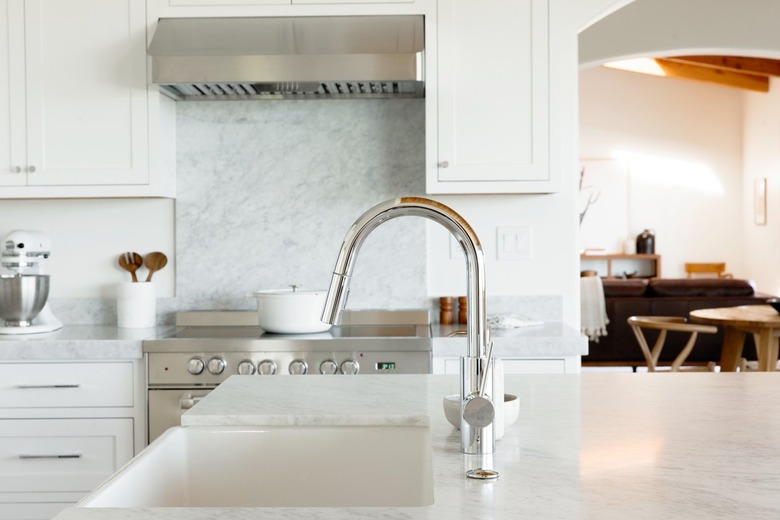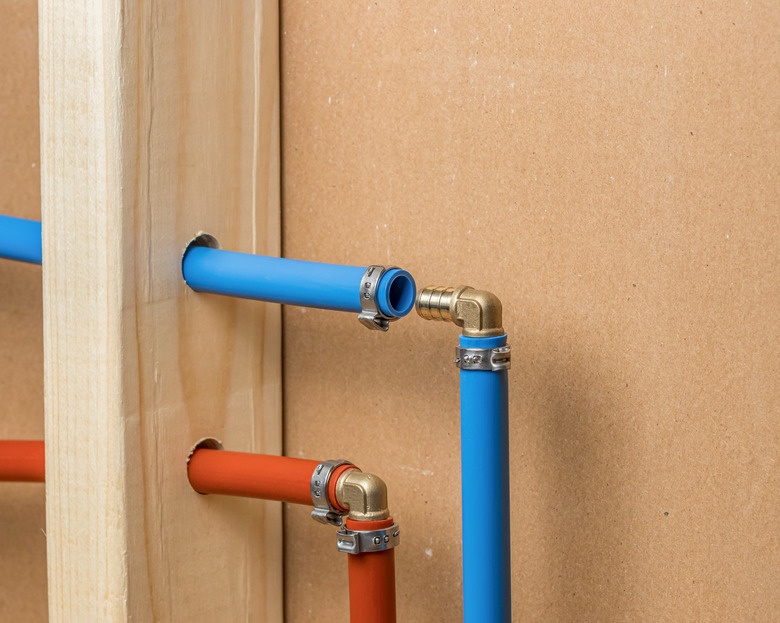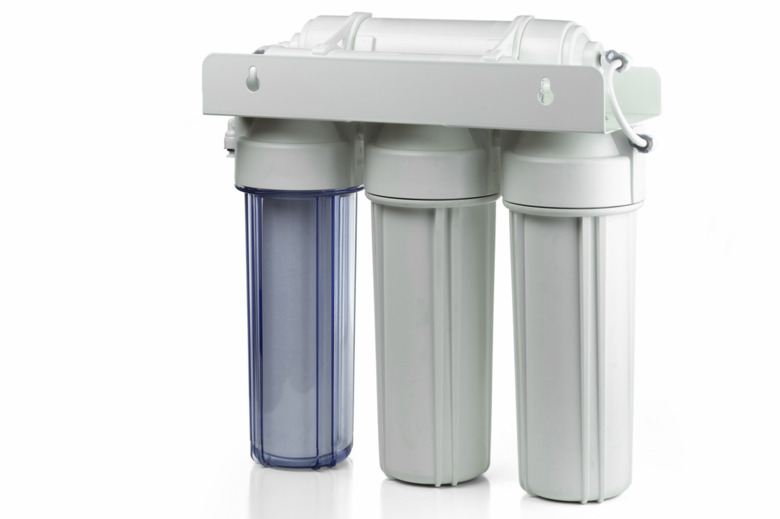How To Install A Whole-House Water Filter: A DIYer's Guide
We may receive a commission on purchases made from links.
If you're concerned about contaminants in your home water supply, a whole-house water filter will help you breathe easier by delivering water that tastes better and is safer for you, your water heater, and the other water fixtures in your home. A water filtration system removes sediment that can settle to the bottom of the water heater tank; hard water minerals that can clog every faucet in the house; and metals, like iron and manganese, that discolor drinking water and give it a metallic taste.
Installing a whole-house water filter is a much more efficient way to guarantee good water quality than installing a filter on every faucet, but it doesn't necessarily eliminate the need for those smaller filters. It all depends on the quality of the water delivered to your house and the type of filtration system you install. Not all whole-house filters can remove both chlorine and chloramines from municipal water, for example, and you sometimes need extra filtration to get rid of the chlorine taste.
There are several water purification methods, and they can be used separately or combined into a single filtration system. You might think this would complicate installation, but it doesn't. In most cases, installing a whole-house water filter is actually a fairly simple DIY plumbing job. It becomes even simpler if you make the connections with PEX tubing, which is flexible, easy to use, leakproof, and practically indestructible. You can use PEX even if your current water pipes are copper.
A Variety of Filtration Methods
A Variety of Filtration Methods
A water filter has to do more than one job. It has to remove sediments, like sand, silt, dirt, and scale, which are more likely to be in well water than municipally supplied water. It has to filter out bacteria and other contaminants. It must remove minerals, like calcium, sulfur, iron, and manganese, and it should make the water taste better by removing chlorine and chloramines. Different filtration systems have been developed for each purpose:
- Sediment filters are typically mesh screens that capture large particles. They can be made from paper, polypropylene, or cellulose, but most contemporary ones use zeolite media. Zeolite is a volcanic rock with a high pore density. A zeolite pre-filter captures sediment before it enters more parts of the filtration system, and these particles are removed by draining or backwashing the media.
- Carbon adsorption is the most common filtration method. An activated carbon filter can remove microscopic particles as well as large molecules to deliver better-tasting and safer drinking water. A standard carbon filter can remove chlorine, but if your water company uses chloramines, you may need to upgrade to a catalytic carbon filter to get rid of them.
- Ion exchange filter media are commonly used in water softeners as well as water filtration systems. They employ electrically charged resin beads that attract minerals, such as calcium and iron.
- Oxidation reduction, or redox, filters employ manganese dioxide as an oxidizer to precipitate iron, hydrogen sulfide, and manganese out of the water. Redox filters are recommended if you have high-mineral well water.
- A reverse osmosis system uses the building's water pressure to force water through a membrane to an area of lower solute concentration, which is the opposite of how osmosis usually works. It's used more frequently on filters for individual faucets than for whole-house filters.
- UV purification systems can be installed in conjunction with whole-house filters to kill bacteria and other pathogens. They are usually installed at the end of the filtration system.
A whole-house water filtration system may contain one or more cartridges to take advantage of these different filtration methods. The cartridges are typically connected to a manifold (aka a central unit) and are installed together, making a multicartridge system no more complicated than one with a single cartridge for installation by a plumber or DIYer.
Working With PEX Tubing
Working With PEX Tubing
Your existing water system may already be plumbed with PEX (cross-linked polyethylene) tubing, but even if you have copper pipes, you can use adapters to switch. Besides being bendable and easier to work with than copper, PEX isn't damaged by ice and is the best plumbing option if there is any danger of freezing pipes in the winter. There are several methods to connect PEX tubing, including compression fittings and expansion connections, but the two most common are crimp rings and push-fit connections.
Push-fit connectors are convenient — just push in the tubing as far as it will go and you're finished — but they are expensive, so it's usually more economical to purchase barbed fittings. The catch is that you need a special crimping tool for the ring that holds the tubing to the connector, and if this is the only plumbing work you plan to do, you may not want to purchase one. However, considering that you are installing your own water treatment system, there's a pretty good chance you'll be doing more plumbing with PEX in the future, so a crimping tool may be a good investment. While you're at it, you should also get a PEX tubing cutter so you can get clean, straight cuts with little effort.
Things Needed
-
Three 3/4-inch PEX ball valves
-
Copper tubing cutter or hacksaw and file
How to Install a Whole-House Water Filter
How to Install a Whole-House Water Filter
You need an accessible location for your whole-house filtration system because you have to periodically remove the filter housing or filter cartridge — which usually just unscrews from the filter manifold — for cleaning and backwashing. It should be as close as possible to the point of entry of the main water line before the hot water line branches off. Most homeowners put their whole-house water filter on a basement wall, but it can also go in the garage or in an outbuilding if that's more convenient (or if you don't have a basement). Note that it's very important that this unit shouldn't be installed outside.
1. Cut Out a Section of the Main Water Pipe
Turn off the main water valve and cut out a section of the water main large enough to accommodate the pipes for the filtration system. At a minimum, you need room for two tees, two ball valves, and the tubing to connect them, but if the filter intersects a straight length of pipe, you need enough room for the whole filtration system, including the manifold, pre-filter, shutoff valves, and tees for a bypass valve. If you have copper pipe, the best way to cut it is with a tubing cutter, but if you lack clearance, use a hacksaw and deburr the pipe edges with a file. Cut PEX pipe with a PEX tubing cutter.
The pipe will be full of water when you cut into it, so put a bucket underneath and allow it to drain completely. Opening one or more faucets in the house will help the water drain faster.
2. Hang the Filter System on the Wall
Screw the manifold bracket for the filtration system to the wall using 3-inch wood screws to secure it to wall studs. If you're installing on a concrete wall, drill holes for plastic wall anchors using a masonry bit and drive screws into the anchors. Use a torpedo level to make sure the bracket is horizontal before you drill screw holes or drive screws.
When the manifold is secure, install the cartridges according to the manufacturer's instructions. They usually screw into the threaded openings on the manifold, and the installation kit may include a special wrench for tightening them. If the system has a pre-filter, mount it on the upstream side of the manifold, leaving enough space between it and the manifold for tubing and connectors.
3. Install Tees and Shutoff Valves
Solder a 3/4-inch copper-to-PEX adapter onto each end of the cut-out section, followed by a short length of PEX tubing, a tee, another length of tubing, and a shutoff valve. If your house already has PEX plumbing, you don't need adapters. Instead, install a PEX coupling onto each cut end before installing the tee and shutoff valve.
The two shutoff valves will allow you to turn off water to the filtration system when it needs servicing, and the tees are for a bypass line that allows water to flow to the house when the filtration system is out of service. If you use barbed fittings, install them using crimp rings and a crimping tool. If you use push-on fittings, simply push the tubing into each fitting as far as it will go — usually about 1/2 inch.
4. Install a Bypass Valve
Install a short length of PEX tubing to the outlet of the upstream tee and connect a third ball valve. Run tubing from the valve outlet to the downstream tee and connect it. This valve remains closed when the filter is in operation, but you can open it when a filter change is in progress so you don't have to resort to bottled water for drinking and cooking.
5. Connect the Filter Manifold and Pre-Filter
If the filter or pre-filter have 1-inch inlet and outlet ports, you need to reduce the opening size to 3/4 inch by screwing in a 1-inch male to 3/4-inch female PVC adapter. Wrap each bushing clockwise with plumbers' tape before screwing it in. Once you have 3/4-inch female threaded openings on all the system components, screw a 3/4-inch male thread to PEX adapter into each one. Don't forget to use plumbers' tape on each fitting and tighten it down with a pipe wrench.
Once all PEX adapters have been installed, connect the upstream ball valve to the pre-filter inlet, the pre-filter outlet to the manifold inlet, and the manifold outlet to the downstream ball valve. Both of the ball valves should be open when the system is in operation.
Do You Want to Add UV Water Purification?
Do You Want to Add UV Water Purification?
A UV purification system is usually installed separately from the main filter, and it's easy to add. It typically mounts on the wall near a wall receptacle, and you connect the inlet port directly to the filter's outlet port. The UV outlet port in turn gets connected to the downstream shutoff valve.
References
- YouTube: iSpring Water Systems – iSpring Whole House Water System DIY Installation
- The Home Depot: How to Install a Whole House Water Filter
- BOS: How to Install a Whole House Water Filter System (Incl. Diagram)
- PureLivingSpace.com: Confused About Whole House Water Filters? Three Little-Known Things You Need to Know
- APEC Water Systems: Basic Whole House Water Filtration Methods Explained
- H2O Distributors: How Reverse Osmosis Works


